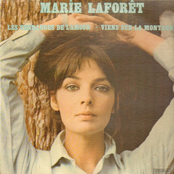Les vendanges de l'amour

Biography
Marie Laforêt (Maïtena Marie Brigitte Doumenach, Soulac-sur-Mer, Gironde, France, 5 October 1939 – 2 November 2019) was a French-Swiss singer and actress. Her career began accidentally in 1959 when she replaced her sister at the last minute in a French radio talent contest Naissance d'une étoile and won. Director Louis Malle then cast the young starlet in the film he was shooting at the time, Liberté, a project he finally abandonded, making Laforêt's first appearance on screen opposite actor A...
Marie Laforêt (Maïtena Marie Brigitte Doumenach, Soulac-sur-Mer, Gironde, France, 5 October 1939 – 2 November 2019) was a French-Swiss singer and actress.
Her career began accidentally in 1959 when she replaced her sister at the last minute in a French radio talent contest Naissance d'une étoile and won. Director Louis Malle then cast the young starlet in the film he was shooting at the time, Liberté, a project he finally abandonded, making Laforêt's first appearance on screen opposite actor Alain Delon in René Clément's 1960 drama Plein Soleil.
After this film she became very popular and interpreted many roles in the 1960s. She married director Jean-Gabriel Albicocco, who cast her in some of his own works, including La Fille aux Yeux d'Or (The Girl with the Golden Eyes), based on the Balzac story, which would become her nickname.
In her second film, Saint Tropez Blues, accompanied by a young Jacques Higelin at the guitar, she sang the title song and immediately started releasing singles, her first hit being 1963's Les Vendanges de l'Amour. Her songs offered a more mature, poetic, tender alternative to the light, teenage yé-yé tunes charting in France at the time. Her melodies borrowed more from exotic folk music, especially South American and Eastern European, than from contemporary American and British pop acts. Laforêt worked with many important French composers,musicians and lyricists, such as André Popp and Pierre Cour, who provided her with a panoply of colorful, sophisticated orchestral arrangements, featuring dozens of musical instruments and creating a variety of sounds, sometimes almost Medieval, Rennaissance or Baroque, other times quite modern and innovative.
At the end of the 1960s, Marie had become a rather unique figure in the French pop scene. Her music stood out, perhaps too much for her new label CBS Records, which expected of her more upbeat, simpler songs. She was interested in making more personal records, but finally gave in. Although her most financially successful singles (Viens, Viens, a cover of a British hit, and Il a neigé sur Yesterday, a ballad about the break-up of the Beatles) were released in the 1970s, Marie progressively lost interest in her singing career, moving to Geneva, Switzerland in 1978, where she opened an art gallery and abandoned music more or less altogether.
In the 1980s, Marie concentrated on her acting career, appearing in a few French and Italian films. Some music singles were eventually released, but were not popular. She made a comeback, however, in 1993 with an album (her last) for which she wrote the lyrics. In the 1990s, she again continued to work as an actress, both on screen and on stage. She has performed in a number of plays in Paris over the years, acclaimed by audiences and critics alike. In September 2005 she took the stage of Les Bouffes Parisiens for a two-weeks sold-out concerts, her first (and last) concerts since 1972. Laforêt moved to Geneva in 1978 and obtained Swiss citizenship.
Records
Marie Laforêt, the folk singer
Laforêt has been fond of folk music ever since she began recording in the early 1960s. She helped popularize the Bob Dylan song "Blowin' in the Wind" in France with her 1963 interpretation. On the B-side of the same EP she sings the classic American folk ballad "House of the Rising Sun". Other folk recordings include: "Viens sur la montagne", a 1964 French adaptation of the African-American spiritual "Go Tell It on the Mountain", recorded by American folk trio Peter, Paul and Mary the previous year, "Coule doux" (Hush-a-Bye), another Peter, Paul and Mary song, 1966's "Sur les chemins des Andes", a French version of the traditional Peruvian song "El Cóndor Pasa", and "La voix du silence", a 1966 cover of American duo Simon and Garfunkel's first hit, "The Sound of Silence".
Marie Laforêt, the rocker
She also recorded some rock songs in the 1960s, her most famous being "Marie-douceur, Marie-colère", a 1966 cover of the Rolling Stones hit "Paint It Black". Another popular recording was 1965's girl group-style "A demain, my darling", known by English-speakers as "The Sha La La Song" written by Marianne Faithfull on her debut eponymous album.
Marie Laforêt, the pop singer
Some of her most memorable pop songs are those written or arranged by French composer André Popp, such as "Entre toi et moi", "L'amour en fleurs", "Les noces de campagne", "Mon amour, mon ami", and "Manchester et Liverpool". The melody of the latter song gained fame in the former Soviet Union as the background music to the Vremya television news programme's weather forecast in the 1970s.[7]
Other important records
The quiet, bittersweet and minimally arranged ballad "Je voudrais tant que tu comprennes" (1966), composed by Francis Lai, is a Marie Laforêt favorite. Homage was paid to the song in the 1980s when French pop superstar Mylène Farmer added it to her own concert repertoire.
The 1973 hit "Viens, viens" was a cover version of a German song "Rain, Rain, Rain" performed by Simon Butterfly.
Marie's 1977 hit "Il a neigé sur Yesterday", perhaps her most well-known recording, was penned by musician Jean-Claude Petit, and lyricist Michel Jourdan, (famous for his work with Dalida, Nana Mouskouri, Michel Fugain and Mike Brant) and who had written the words for earlier Laforêt songs, such as "Les vendanges de l'amour" and "L'orage". Read more on Last.fm. User-contributed text is available under the Creative Commons By-SA License; additional terms may apply.
